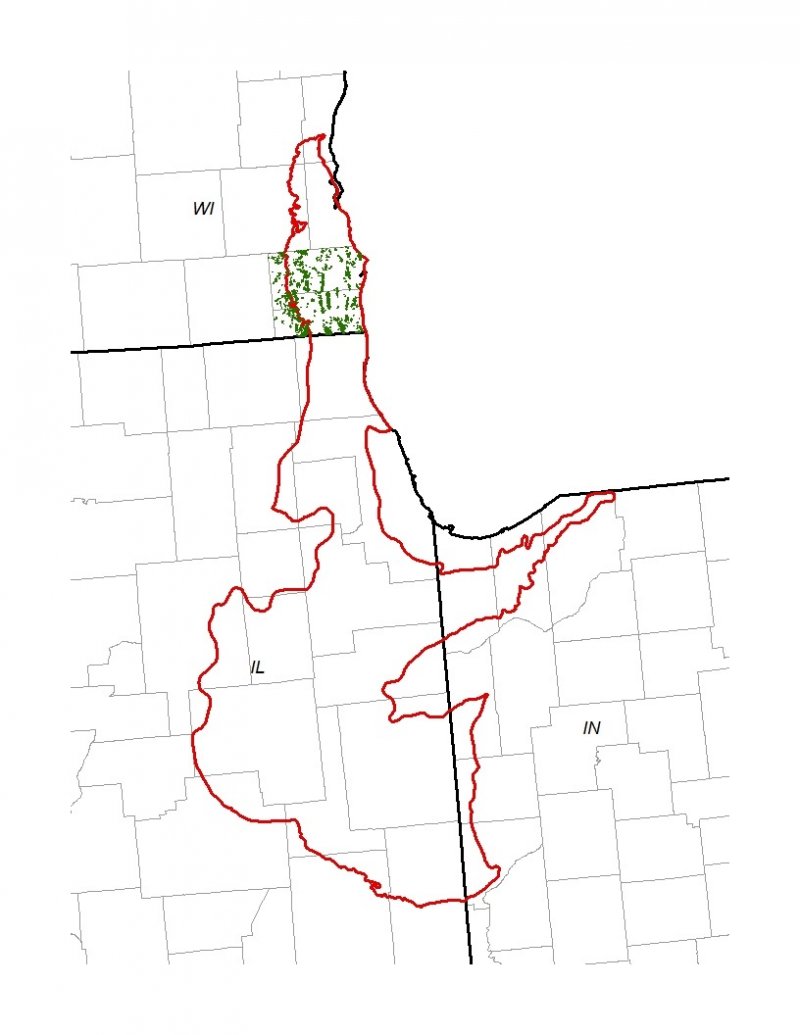
Natural Resources
Conservation Service
Ecological site F110XY026IL
Lacustrine Swamp Forest
Last updated: 4/22/2020
Accessed: 12/21/2025
General information
Provisional. A provisional ecological site description has undergone quality control and quality assurance review. It contains a working state and transition model and enough information to identify the ecological site.
MLRA notes
Major Land Resource Area (MLRA): 110X–Northern Illinois and Indiana Heavy Till Plain
The Northern Illinois and Indiana Heavy Till Plain (MLRA 110) encompasses the Northeastern Morainal, Grand Prairie, and Southern Lake Michigan Coastal landscapes (Schwegman et al. 1973, WDNR 2015). It spans three states – Illinois (79 percent), Indiana (10 percent), and Wisconsin (11 percent) – comprising about 7,535 square miles (Figure 1). The elevation is about 650 feet above sea level (ASL) and increases gradually from Lake Michigan south. Local relief varies from 10 to 25 feet. Silurian age fractured dolomite and limestone bedrock underlie the region. Glacial drift covers the surface area of the MLRA, and till, outwash, lacustrine deposits, loess or other silty material, and organic deposits are common (USDA-NRCS 2006).
The vegetation in the MLRA has undergone drastic changes over time. At the end of the last glacial episode – the Wisconsinan glaciation – the evolution of vegetation began with the development of tundra habitats, followed by a phase of spruce and fir forests, and eventually spruce-pine forests. Not until approximately 9,000 years ago did the climate undergo a warming trend which prompted the development of deciduous forests dominated by oak and hickory. As the climate continued to warm and dry, prairies began to develop approximately 8,300 years ago. Another shift in climate that resulted in an increase in moisture prompted the emergence of savanna-like habitats from 8,000 to 5,000 years before present (Taft et al. 2009). Forests maintained footholds on steep valley sides, morainal ridges, and wet floodplains. Fire, droughts, and grazing by native mammals helped to maintain the prairies and savannas until the arrival of European settlers, and the forests were maintained by droughts, wind, lightning, and occasional fire (Taft et al. 2009; NatureServe 2018).
Classification relationships
USFS Subregions: Southwestern Great Lakes Morainal (222K) and Central Till Plains and Grand Prairies (251D) Sections; Kenosha-Lake Michigan Plain and Moraines (222Kg), Valparaiso Moraine (Kj), and Eastern Grand Prairie (251Dd) Subsections (Cleland et al. 2007)
U.S. EPA Level IV Ecoregion: Kettle Moraines (53b), Illinois/Indiana Prairies (54a), and Valparaiso-Wheaton Morainal Complex (54f) (USEPA 2013)
National Vegetation Classification – Ecological Systems: North-Central Interior and Appalachian Rich Swamp (CES202.605) (NatureServe 2018)
National Vegetation Classification – Plant Associations: Acer (rubrum, saccharinum) – Fraxinus spp. Ulmus americana Swamp Forest (CEGL005038) (Nature Serve 2018)
Wisconsin Natural Communities: Southern Hardwood Swamp (WDNR 2015)
Ecological site concept
Lacustrine Swamp Forests are located within the green areas on the map. They occur on lake plains. The soils are Mollisols that are ponded and very poorly to poorly drained, formed in lacustrine deposits.
The historic pre-European settlement vegetation on this ecological site was dominated by hydrophytic woody and herbaceous species. Red maple (Acer rubrum L.) and green ash (Fraxinus pennsylvanica Marshall) are the dominant trees, with silky dogwood (Cornus amomum mill.) and common winterberry (Ilex verticillata (L.) A. Gray) the dominant shrubs and hop sedge (Carex lupulina Muhl. ex Willd.) and jewelweed (Impatiens capensis Meerb.) the dominant herbaceous species on the site. A variety of other hardwood trees can occur including American elm (Ulmus americana L.), silver maple (Acer saccharinum L.), bitternut hickory (Carya cordiformis (Wangenh.) K. Koch), hackberry (Celtis occidentalis L.), and black ash (Fraxinus nigra Marshall) (WDNR 2015). Species indicative of an undisturbed plant community associated with this ecological site includes ravenfoot sedge (Carex crus-corvi Shttlw. Ex Kunze), blue ash (Fraxinus quadrangulata Michx.), and Kentucky coffeetree (Gymnocladus dioica (L.) K. Koch) (Bernthal 2003). Ponding is the primary disturbance factor that maintains this ecological site, while windthrow, drought, and fire are secondary factors (WDNR 2015).
Associated sites
| F110XY012IL |
Moist Glacial Drift Upland Forest Loess or other silty or loamy material, loamy outwash, glacial till, or lacustrine deposits with a water table within 18-72 inches including Aptakisic, Blount, Del Rey, Nappanee, Ozaukee, Sabina, Starks, St. Clair, Tuscola, and Whitaker soils |
|---|
Similar sites
| F110XY028IL |
Silty-Loamy Floodplain Forest Silty-Loamy Floodplain Forests have a similar vegetation type, but the site is a RIVERINE wetland |
|---|
Table 1. Dominant plant species
| Tree |
(1) Acer rubrum |
|---|---|
| Shrub |
(1) Cornus amomum |
| Herbaceous |
(1) Carex lupulina |
Click on box and path labels to scroll to the respective text.



